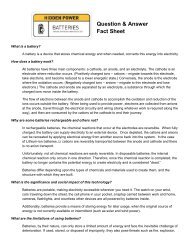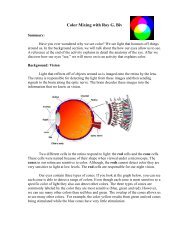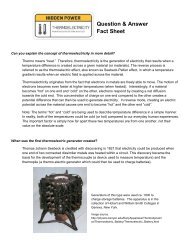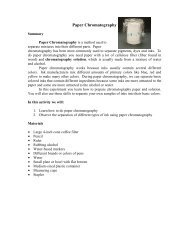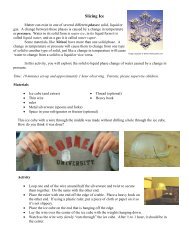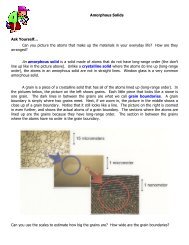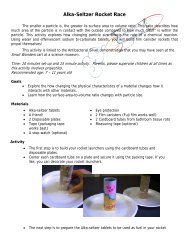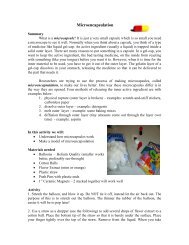Executive Summary Final - the Center for Nanoscale Science - an ...
Executive Summary Final - the Center for Nanoscale Science - an ...
Executive Summary Final - the Center for Nanoscale Science - an ...
Create successful ePaper yourself
Turn your PDF publications into a flip-book with our unique Google optimized e-Paper software.
IRG 4: Electromagnetically-Coupled N<strong>an</strong>ostructures<br />
Figure 1. Sub-wavelength n<strong>an</strong>oscale imaging is<br />
import<strong>an</strong>t in <strong>the</strong> materials <strong>an</strong>d biological sciences.<br />
Our modeling shows that <strong>the</strong> high index contrast<br />
possible in tapered, semiconductor filled MOFs<br />
makes <strong>the</strong>m very attractive <strong>for</strong> this application,<br />
allowing <strong>for</strong> unprecedented light throughputs with<br />
sub-wavelength resolution.<br />
Development of <strong>the</strong> high-pressure materials chemistry<br />
necessary <strong>for</strong> semiconductor growth in <strong>the</strong><br />
fiber geometry with accurately controlled, shallow<br />
electronic dop<strong>an</strong>t levels, sharply defined homo<br />
<strong>an</strong>d heterojunction layers <strong>an</strong>d minimal material<br />
Fig. 2. High speed (3 GHz) silicon pin photodiode<br />
defects has allowed <strong>the</strong> IRG to fabricate p-i-n<br />
fabricated in a silica optical fiber pore.<br />
junctions in MOF templates by successive deposition<br />
of layers, as shown in Figure 2 above. These<br />
junctions exhibit well-defined rectifying curves, good fill-factor (55%), <strong>an</strong>d have up to 3 GHz<br />
b<strong>an</strong>dwidth <strong>for</strong> infrared light, a major step <strong>for</strong>ward towards all-fiber optoelectronics.<br />
The high pressure deposition approach used to fill pores in MOFs must be understood be<strong>for</strong>e it<br />
c<strong>an</strong> be fully exploited. The IRG has modeled <strong>the</strong> flow of high pressure fluid/gas within <strong>the</strong> MOF<br />
pores <strong>an</strong>d its effect on <strong>the</strong> deposition reaction that produces well developed micro- or n<strong>an</strong>ostructures.<br />
This modeling has revealed how it is possible to completely fill optical fiber pores to<br />
make low-optical-loss waveguides: hydrogen reaction byproducts <strong>an</strong>d helium carrier gas c<strong>an</strong> exit<br />
<strong>the</strong> fiber through <strong>the</strong> silica walls, allowing <strong>for</strong> a sequential backfilling process. We find that<br />
much higher precursor concentrations are possible in <strong>the</strong> confined geometry of <strong>the</strong> fiber pores<br />
because n<strong>an</strong>oparticles that might nucleate <strong>an</strong>d grow in larger reactors rapidly find <strong>the</strong> pore walls<br />
in <strong>the</strong> confined geometry. The higher precursor concentrations possible in <strong>the</strong> confined geometry<br />
allow <strong>for</strong> enh<strong>an</strong>ced deposition rates <strong>an</strong>d lower reaction temperatures compared with <strong>an</strong>y conventional<br />
CVD. The insights obtained from modeling have allowed <strong>for</strong> <strong>the</strong> fabrication of void-free<br />
a-Si:H fibers with optical losses less th<strong>an</strong> 3 dB/cm. It has not previously been possible to fabricated<br />
a-Si:H microwires <strong>an</strong>d n<strong>an</strong>owires because traditional techniques such as vapor-liquid solid<br />
growth c<strong>an</strong>not be used <strong>for</strong> amorphous <strong>an</strong>d hydrogenated materials. Now <strong>the</strong> superior nonlinear<br />
optical properties of this material c<strong>an</strong> be exploited over long lengths in fibers. Fur<strong>the</strong>rmore, we<br />
are extending this high pressure deposition in a confined geometry approach enable ultracon<strong>for</strong>mal<br />
deposition in deep features on pl<strong>an</strong>ar substrates. For example, it should be possible to<br />
fabricate p-i-n silicon junctions in pores of polyimide sheets <strong>for</strong> pillar array solar cells. The resulting<br />
periodic pl<strong>an</strong>ar structure is more akin to that of <strong>the</strong> 2D meta-material work described below<br />
<strong>an</strong>d thus illustrates <strong>the</strong> connection between <strong>the</strong> two main ef<strong>for</strong>ts within this IRG; (note also<br />
<strong>the</strong> quasi-2D structure of <strong>the</strong> sub-wavelength IR waveguide array described above). In exploratory<br />
work, <strong>the</strong>se techniques have also allowed us to deposit void-free amorphous <strong>an</strong>d crystalline<br />
sp 2 -bonded carbon fiber cores. We find that <strong>the</strong>ir strength thus far is as high as 4 GPa <strong>an</strong>d <strong>the</strong>y<br />
c<strong>an</strong> sustain strains of up to 4%. High strength carbon wires have never been made from precursors<br />
such as meth<strong>an</strong>e be<strong>for</strong>e. We intend to extend <strong>the</strong>se techniques in <strong>the</strong> coming year, with <strong>the</strong>



